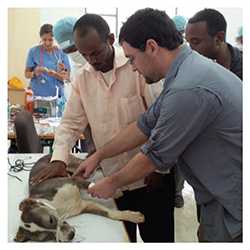NCEZID: Deadly and Unexplained Diseases
Germs that cause Ebola, anthrax, rabies, smallpox, and plague, also called “high-consequence pathogens,” require expert oversight, especially because of the threat of bioterrorism. NCEZID places a high priority on understanding and tracking these diseases domestically and globally, operating state-of-the-art laboratories that can identify them, and preventing their spread.
What we’re doing:
- NCEZID studies diseases caused by highly hazardous bacteria (like anthrax) and viruses (like Ebola). After the Ebola epidemic of 2014, scientists continue to conduct followup studies with survivors to learn what long-term symptoms they may face, how long the virus can persist, and how some people are better able to survive Ebola.
- NCEZID scientists also investigate unexplained deaths and diseases of unknown origins. Uncovering new infectious diseases contributed to the identification of the agents that cause SARS and hantavirus pulmonary syndrome. Recently, NCEZID pathologists were amazed when they found a new disease—tapeworms growing inside a person essentially getting cancer that spreads to the person, causing tumors. It is the first-known case of a person becoming ill from cancer cells that arose in a parasite—in this case, the dwarf tapeworm, the most common tapeworm in people.
- An important part of the mission to keep deadly diseases at bay is to investigate and find new ways to prevent zoonotic infections that spread between animals and people. Although rabies is a vaccine-preventable disease, close to 60,000 people die from the disease around the world each year. The NCEZID Rabies Team has traveled throughout the world to reduce rabies in countries like Ethiopia, Vietnam, and Haiti, where rabies from dogs is common.
NCEZID has world-renowned experts in the world’s deadliest diseases like Ebola, anthrax, and rabies.
- Page last reviewed: August 28, 2017
- Page last updated: August 28, 2017
- Content source:
Centers for Disease Control and Prevention
National Center for Emerging and Zoonotic Infectious Diseases (NCEZID)


 ShareCompartir
ShareCompartir
